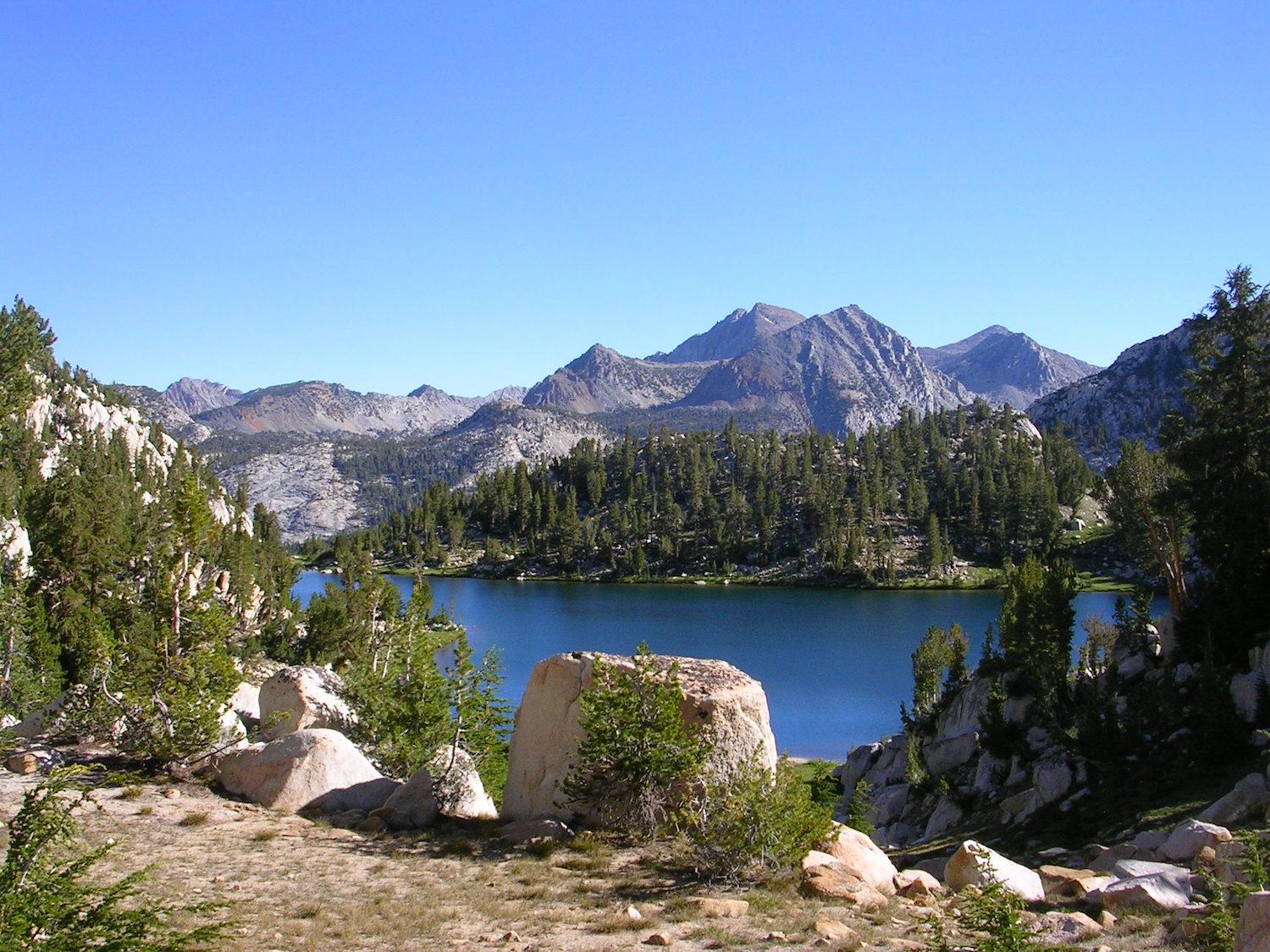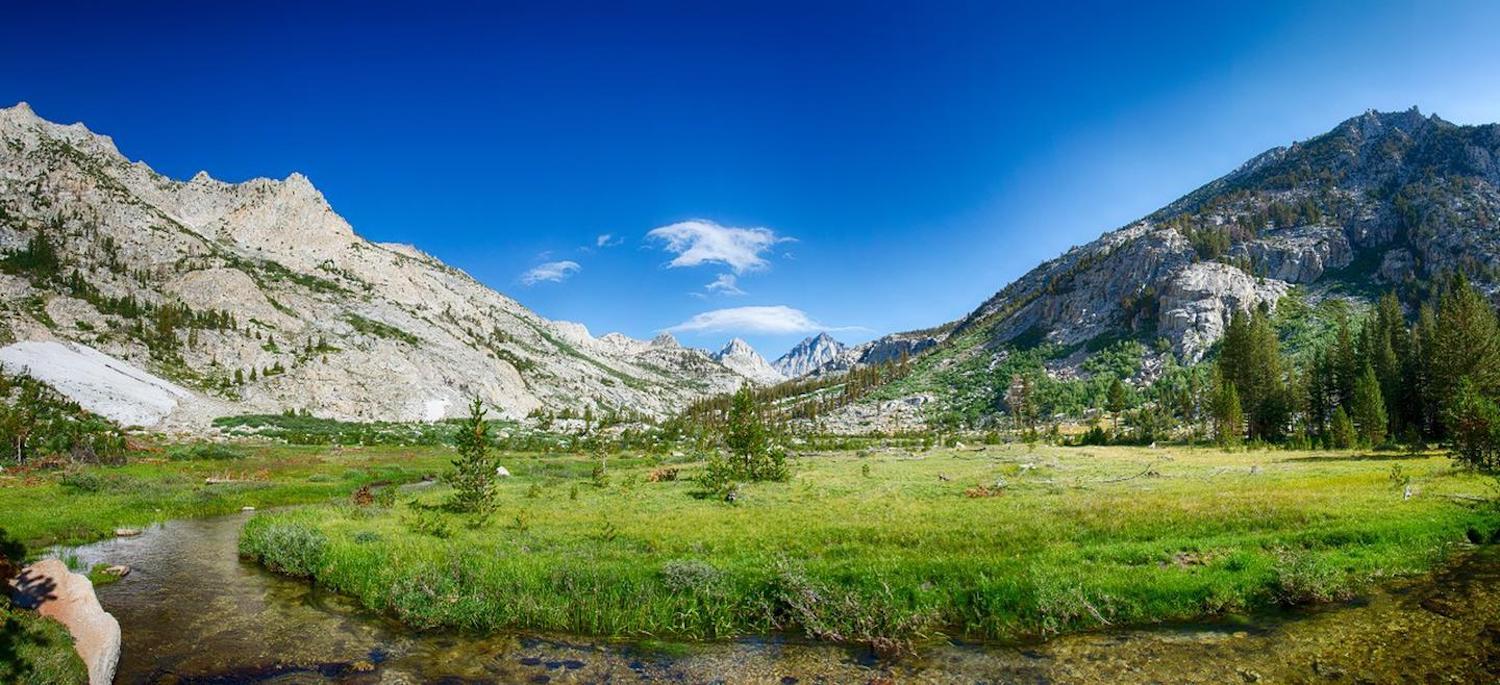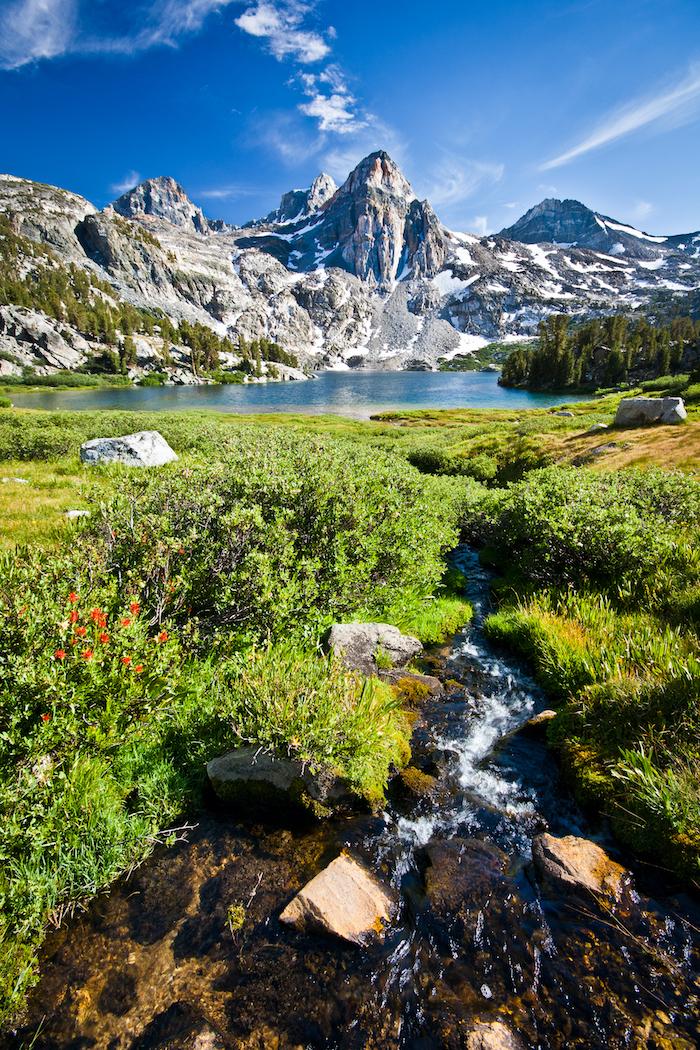
Lake of the Lone Indian, Sierra National Forest/Wikimedia Commons
A 1.3-Million-Acre Approach To Preserving Nature
By Kurt Repanshek
Once she overcame her fear of living beneath the thin nylon roof of her tent on the floor of the Sierra National Forest, Deanna Lynn Wulff was captivated by the surrounding beauty.
“I’d wake up and the sun would be shining through the trees, and the birds would be singing, there’d be this flow of water,” she said. “Chipmunks running around, and the smell of the forest. Such a wonderful smell. ... This experience altered the rest of the course of my life.”
That experience 25 years or so ago, necessitated by low wages as a waitress and a need to pay tuition bills, sent Wulff on a mission to ensure the landscape of the 1.3-million-acre Sierra National Forest gained better protection. Protection, she said, to save its forests from logging and the roads that go along with that activity, and to focus more on restoration of the landscape.
"When you go in to protect the place, you want to think about the longer term," she told me when we talked earlier this summer.
The bold aspect of her vision, dubbed Unite the Parks, won't come easy. It's to transfer the national forest with its old growth groves of giant sequoias, river-cut canyons, more than 500,000 acres of official wilderness, and spectacular High Sierra scenery to the National Park Service and redesignate it as Range of Light National Monument.
It's a move, Wulff believes, that not only would better protect the High Sierra, but provide jobs.
"You need to put people to work. And one way to do that is to say we're going to make this into a monument," she said. "And we're going to build trails, and we're going to restore the landscape. And we're going to put funding behind that. That's really, really important if you're looking at the long-term economic welfare of the people who live there."
Such a transfer could do much more than protect forests from logging and create jobs for locals, though. Look about the West during this fiercely hot summer and you'll see how climate change is impacting the region through wildfires that are more intense than others in recent history. There is the drought draining lakes Powell and Mead. Wildlife is facing the sixth mass extinction. The Biden administration wants 30 percent of the country's lands and waters preserved for nature by 2030.
Shifting the Sierra National Forest to the Park Service could address each of those issues in some fashion, believe its proponents. (An additional benefit could be reduced crowding seen in many parts of the National Park System, for while national forests provide outlets for people searching for space in the outdoors, a national park designation seems to greatly influence their decision on where to go.)

Laurel Creek Basin in the Sierra National Forest/USFS
Located as it is between Yosemite National Park to the north and Kings Canyon National Park to the south, such a change in agency management would create a nearly 3-million-acre block of parklands when you consider Kings Canyon butts up to Sequoia National Park to the south.
"To reconnect ecosystems, one of the problems that we face is the areas that we set aside for protection are often isolated," Dr. Stuart Pimm, an expert on global patterns of habitat loss and species extinction based at Duke University and one of more than 200 scientists and academics who have endorsed Wulff's "Unite the Parks" initiative, said during a phone call.
While many protected areas in the West are large, he went on, they're not always large enough "to have a sort of functioning ecosystem that the major predator species need to be able to roam across."
Stitching together Yosemite, a Range of Light National Monument, Kings Canyon National Park, and Sequoia National Park would create a greatly protected ecosystem almost as large as Death Valley National Park, which is nearly 3.4 million acres.
Pimm appreciates that the national forest designation offers some protection for the land and waters within the Sierra National Forest, but argues that it doesn't go far enough. The Forest Service, he pointed out, is in the business of multiple use.
"The major predators, the bears, pumas, wolves, species like that, need to be able to roam across very extensive landscapes," said Pimm. "In this particular case, you might think it's already national forest land, so what's the point of making it a national monument? Well, I think the simple answer to that is that national forests, for whatever reason, are multiple use, there is a strong component of forest exploitation within national forests. And that often leaves the forest being fragmented, it often leads to them being degraded. This would be a way of greatly improving the forest protection and bringing them back to old-growth forest, rather than forests that are constantly being logged."

An unnamed lake below the Ansel Adams Wilderness, Sierra National Forest/USFS
Pimm also noted that the Convention on Biological Diversity this summer released its draft Global Biodiversity Framework, in which the need for expansive protected areas for wildlife was stated.
"Despite ongoing efforts, biodiversity is deteriorating worldwide and this decline is projected to continue or worsen under business-as-usual scenarios," said the document. Policy actions are needed to not just stop that decline by 2030, it adds, but allow "for the recovery of natural ecosystems" by 2050, at which time the Convention's "vision of 'living in harmony with nature'" will have been accomplished.
"Connectivity is a very key piece of that. It's not just a matter of, you know, protecting more of the landscape. It's a matter of connecting up the landscapes that we have. In fact, one of the milestones is the net gain in the area connectivity and integrity of natural systems," explained Pimm. "Throughout this document, there is a statement that we need to be reconnecting nature. And that's what this will do. It'll connect two large national parks, and make them functionally even bigger."
The Forest Service itself appreciates the role the Sierra National Forest can play in muting climate change, noting in its planning documents that the Nelder grove of about 100 giant sequoias is valuable as a resource in case the warming climate impacts the sequoias in Kings Canyon and the Giant Sequoia National Monument.

Rae Lakes Creek, Kings Canyon National Park/Jeffrey Pang CC by 2.0
Yet Wulff's vision is not one easily attained. Not only is there a private Facebook group with 5,500 members opposing her efforts, but U.S. Rep. Tom McClintock, in whose district the Sierra National Forest lies, is a strong proponent of not just logging but of multiple use of public lands.
Ryan Henson, the policy director at the California Wilderness Coalition, said the organization hasn't closely followed Wulff's campaign, but feared there would be too much opposition today to transfer a parcel of national forest to the Park Service.
"It happened a great deal in the past. Absolutely. Lassen (Volcanic) National Park, Sequoia-Kings Canyon, all of those were carved out of national forests," said Henson. "Used to be very, very common. But the Forest Service has fought it really hard as an agency. That's one of the reasons that they've worked to become a little better at conservation in part, in competition with the Park Service. But, I mean, they, Congress never switches from agencies. Very rarely. The last time they did it in California was switching from the (Bureau of Land Management) to the National Park Service in the Mojave National Preserve. It took 15 years to pass the bill. It actually happened. Maybe I shouldn't say it wouldn't happen."
"Visionary proposals" such as Wulff's are needed, he added after a bit. "You never know with these things. And god bless her for trying. Just because I'm focused on this more immediate stuff, like next year's budget. I think what she's doing is super important."
Wulff would certainly agree with that statement.
"It would restore the forest to its former glory, stop commercial logging of our last living trees. And would create a recreational paradise for people, and a wildlife refuge for all of those species out there that need it," she said.

 Support Essential Coverage of Essential Places
Support Essential Coverage of Essential Places
Comments
Good idea, but there are some trade-offs. Make it a National Park and people will rightly demand MORE access-- roads, facilities, amenities, and of course visitation itself-- that will work against the very wilderness you already have and want to preserve. And if you don't, you are denying what the Park Service was supposed to do, which is preserve people's ACCESS to appreciate these special places; most of us do not have the health or wealth to hike into it very far. The High Sierra, especially the Muir trail through that stretch, is absolutely wonderful. I'm not sure this designation solves the problem.
Great idea, but it would be even better to make the Range of Light a full National Park designated by Congress.
The establishment of this monument or park would REDUCE development, not increase it. The idea that lands would be better protected kept under the "management" of the Forest Service or BLM is a serious misconception. The parks that are mainly used as examples of parks being "loved to death" are classic parks created back in the days when maximum railroad and auto access were seen as progressive. None of the newer national parks have this kind of intrusive new access. These newer parks, such as North Cascades, Voyageurs, Great Basin, Congaree, Great Sand Dunes, Death Valley, Joshua Tree, and the Alaska parks, have not built any major new infrastructure and large portions of these parks are designated wilderness.
Even the supposedly "developed" parks are mostly undeveloped. Over 50 percent (43.9 million acres) of national parklands are designated as Wilderness, by far the largest amount of any federal agency. In contrast, only 19 percent National Forest, 14 percent of National Wildlife Refuge, and 4 percent of BLM lands are designated as Wilderness. Even most "crowded" National Parks have vast, wild backcountry. Designated or recommended Wilderness areas encompass more than 80 percent of the entire National Park System, including almost 92 percent of Yellowstone, 89 percent of Yosemite, and 85 percent of Zion National Park.
Even if public recreation increased in some areas, the damage it causes does not come close to the damage caused by logging, livestock grazing, mining, fracking, roadbuilding, fire suppression, and other Forest Service "management" activities.
The Forest Service has a huge road network that was built to facilitate logging and other industrial exploitation. National monument or national park designation would ban logging, allowing most of these environmental harmful and expensive-to-maintain roads to be closed or turned into non-motorized trails.
So we should want more national parks (with roadless areas designated as Wilderness), not just to take visitor pressure off of existing parks, but also to provide stronger protection for these lands and waters than any other type of designation.
Wulff's vision simply falls short and does not aim to get this land the best legal protection it can recieve, protection it deserves. A Wilderness designation would offer greater protection and should be persued for every acre that meets the criteria.
Hi! Deanna here. Great comments! Thank you for writing. It can be hard to discern all the technical details and time I've spent developing a comprehensive and thoughtful plan. I do support Wilderness - it's great! But we also have to think about who is managing the area. As I write this, all National Forests in CA are closed. About half them are on fire. Only our National Parks remain open. There are many reasons for that. Among them, USFS lacks the ability to control ignitions on its sprawling roads and the agency doesn't have staff assigned to patrol those roads in the way that the Park Service does. Then, there is the ecological issue. The NPS is managing mostly for the health of the natural environment, and in doing so, has created a more fire resilient landscape. Notably, the two parks aren't on fire, and they are mostly Wilderness. Also, with NPS, you have a lot more people put to work on the few roads they manage. Yosemite employs about five times as many people as the nearby Forest, and it's half the size (this is in summer). In the winter, it increases to nine times as many people. That's just federal employment, not the associated jobs in recreation and tourism.
When we consider protecting an area, we should consider the people living there, and how our actions will affect them. Wilderness is wonderful, but it doesn't provide jobs or a future for the people living next to it. When we create the Range of Light National Monument, to be managed by the Park Service, it will build a future for both the environment and the economy. It's the full package.
Why a monument and not a park? First, it's likely what we can achieve. Second, the land needs to be repaired. Third, the President can designate a monument, in spite of the special interests who always show up to dismantle actions that benefit most people and wildlife, over them. That's the purpose of the Antiquities Act; Roosevelt understood what would be required to get large areas protected. You can't please everyone and be effective.
Beyond that, of course, I don't want my favorite special place to become crowded. I spent a lot of time mulling that over - and I've designed maps and a road system that might mitigate this, which would disperse people, rather than concentrating them in one place. Yosemite Valle has three highways converging into it, which is a big problem. Finally, I don't know a way to save a place without sharing it, and that means more people will go there. But I'd rather see trees, picnic tables, trails, and happy people enjoying nature, than logging trucks destroying what's left of our forests and the beautiful wildlife we are so lucky to enjoy.
If you want to participate more fully, please reach out to me at [email protected] or endorse the proposal on our web site: www.unitetheparks.org. Thank you!
The ecological issue is perpetuated by human development - such as roads, septic systems, electric grids, lighting, and all the structures constructed and labeled as Towns, Neighborhoods, and Parks. Parks are great, and their town-like amenities are nice, but this is all to the detriment of ecology. Human development brought in by parks leads to such ecological degredation as habitat fragmentaion (which is one of the leading causes of species extenction), silt and machinery polutants enerting the soil and water, increased invasive flora and fauna to name just a few, and all of which can be minimized by managing the land as designated Wilderness.
Wildernes supports our economy and provides longterm jobs not just from people traveling in them by self-powered or animal-powered means but by attracting people to the general viciniity where they build thriving towns and parks just beyond the Wilderness border. Think Mammoth Lakes, Bishop, etc.. Wilderness keeps development and overcrowding at bay while further development is merely self perpetuating. Just as many roads are still crowded and need further widening and extension by the time their last widening project gets completed the same thing is happening in many of our parks, Yosemite included. With our population exploding and more and more people wanting to play outside, what little is left of the very wilderness we claim to love needs to be preserved, not developed.
Beautiful area to the south of Yosemite! While admirable it will take a while for this to be designated, if at all. The reason I say this is President Biden has yet to pass any wilderness legislation. Bears Ears and Escalante have not been restored thus far! Great idea, but I don't see this happening any time soon.
As a big supporter of the NPS and the other land management agencies, I understand the differences in all the agencies and their management of resources and finances. But, the problem also lies within taking mountain bike trail areas away from recreation and land lovers as well. The NPS fails to support bike trails for users and if this was switch hands, you will have many recreational bike riders without trails....again. A Monument designation will not help the recreational users.
This is a bad idea! why, because the Sierra National Forest already has more designated wilderness acres than general forest acres. All of the photos are from areas within the wilderness and protected from activities such as logging or road building. Forest Service management requires multiple use approach including wilderness, natural resource and recreation activities. The last 30 years have continually reduced activities to a no touch approach that has resulted in poor forest management, increased fire destruction and over use of the lands that are still avaiable for recreation use. If you want to do something positive advocate for better forest health management practices. ( retired FS employee 41 years)